
Olive Ridley turtle
Credit: Special Arrangement
Mumbai: Environmentalists are elated that an Olive Ridley turtle, that has created a record by travelling across 3,500 km from Gahirmatha Marine Sanctuary in Odisha to Ratnagiri district has laid 120 eggs at Guhagar beach.
Of these, as many as 107 hatchlings have been released into the sea, Mangrove Division-South Konkan has confirmed.
The turtle with the metal tag number ‘03233’ was noticed at Guhagar on January 31,2025, Divisional Forest Officer Kanchan Pawar told NatConnect Foundation.
The 'Kasav Mitra' (friends of turtles) volunteers deployed by the Mangrove Foundation noticed the Olive Ridley Turtle and ensured its safety.
The turtle was safely released back into the sea and between March 23 and 26 as many as 107 hatchlings were released, Pawar said. The maximum number of 74 hatchlings were counted on March 24.
The turtle, tagged as ‘03233’ at Gahirmatha beach in Odisha on March 21, 2021 has travelled over 3,500 km to Guhagar beach in Maharashtra’s Ratnagiri district where it was noticed on January 31, 2025.
Zoological Survey of India (ZSI) senior scientist Dr Basudev Tripathy who has been working on tagging the turtles said he was pleasantly surprised to note that this turtle with the metal tag‘03233’ has been noticed in the western coast.
Turtles, he said, play a major role in our biodiversity and even help the fishing community by eating the unwanted jelly fish and maintaining the health of marine habitats.
NatConnect Foundation Director B N Kumar said it is very interesting that the turtle travelled such a long distance and laid eggs.
He said the metal tagging of the reptiles gives very limited knowledge. The scientists get to know only the date, place of tagging and by whom but the turtle’s stopovers and swimming route remains a mystery.
As sea turtles can migrate huge distances, they also play an important role in generating and maintaining diversity throughout the world’s oceans by transporting the organisms that live on them to and from reefs, seagrass beds and the open ocean, according to the Olive Ridley Project website.
They come to the seashores to form protective nests in the mud and lay eggs to move back into the sea.